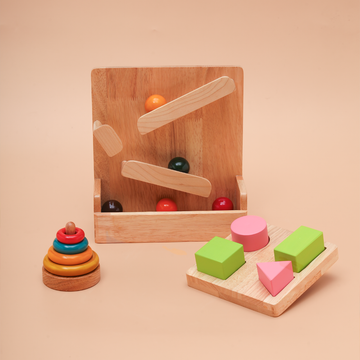Montessori Kit 12M+
300k+ Babies growing with our product
Similar Products
Estimated Shipping Widget will be displayed here!

Montessori Kit 12M+


Why Ariro's Montessori Kit?
- Curated age-appropriately by Montessori experts for 12-24 Month toddlers
- Helps with Hand-eye Coordination.
- Aids Problem Solving.
- Supports mid-line crossing
- Offers opportunity to understand cause and effect
- Smoothly finished in sturdy wood
- Each product is handcrafted with care and perfection with child-safe paints.
The perfect Montessori kit for 1 year old Toddler
Are you confused about what to buy for your 12 to 24-month-old?
No more worries! Here is a perfect Montessori kit that has been developed by experts to support your child's growth over the following three months. This set is the ideal combination of toys that encourage Problem solving, language and mathematical understanding, experiencing cause and effect and encourage independent play.
Stacking toys offer more than just play—they help toddlers develop hand-eye coordination, fine motor skills, and problem-solving abilities while strengthening their grasp and release movements. As children explore stacking, they also build an understanding of spatial relations and numbers, learning about sizes, fitting objects together, and even early counting and sequencing. This activity fosters language development, introducing words like "big," "small," and prepositions such as "on top of" or "under," while also helping with color recognition. Once the primary goal of stacking is achieved, creative play takes over, allowing for cognitive growth and imaginative exploration.
The Montessori Tracking Toy is an exciting way for babies to learn cause and effect as they watch colorful balls slide down, keeping them engaged and captivated. This activity supports cognitive development, challenging little ones to understand the toy’s dynamics and strengthening their problem-solving abilities. As they pick up and slide the balls, they refine fine motor skills, which are essential for future tasks like holding a pencil or using scissors. Additionally, the toy enhances language development, introducing colors, numbers, and prepositions in a fun and interactive way.
Puzzles for toddlers offer numerous benefits, from enhancing hand-eye coordination and fine motor skills to improving spatial understanding as they explore shapes and sizes. They also aid brain development by sharpening problem-solving skills, boosting concentration, and supporting cognitive growth. Engaging in puzzles fosters language development, as parents can guide the process using descriptive words, introducing colors, shapes, and prepositions. Additionally, puzzles encourage creative play, allowing little ones to experiment and build, but parental guidance is necessary at all times.
Why Play?
Kindles Problem Solving Abilities
The puzzles challenge toddlers to problem-solve by fitting pieces together, enhancing spatial awareness and logical thinking skills as they explore shapes and sizes
Encourages Independent Play
Promotes autonomy and exploration with age-appropriate toys designed for grasping, stacking, and tracking. These toys support independent play, fostering self-discovery and cognitive growth as infants interact with their environment.
Aids Fine Motor Skills
Supports the refinement of hand-eye coordination and fine motor skills through activities like grasping, pushing, and manipulating puzzle pieces. Each toy in the Montessori Kit encourages infants to develop precise movements and dexterity essential for future tasks.
Understand Cause & Effect
Teaches children that actions have consequences as they observe the colorful balls sliding down. This fundamental concept of cause and effect enhances cognitive growth and logical reasoning abilities.
Aids Mathematical Exploration
Introduces foundational math concepts such as size, order, and sequencing, helping your child understand numbers, spatial relationships, and basic counting through hands-on play, which lays the groundwork for future mathematical learning
Simple Wooden Stacker
-
Show the child how the stacker is stacked starting from the smallest arch.
- On another day, after sufficient exploration, show the child how it can be stacked from the biggest arch first creating a tower.
- Create a ball track by arranging two arches together where the bigger arch encloses the smaller one.
- Let the child explore freely for imaginary play with some add on elements like animal figurines.
Classic Ball Slider
-
show with one ball how to place it on the top slide and allow it to roll
- Offer multiple balls only after the child has mastered the one ball
- Introduce numbers with only the balls
Wooden Block Puzzle
- Introduce the puzzle when you see your toddler exhibiting palmar grasp and can sit firmly without any support
- Show how to place the solid object into the respective socket and take it out
- On another day you can offer only the blocks so they can explore other activities like stacking and more
Product Weight: Simple Stacker - 146 g Classic Ball Slider - 1130 g Block Puzzle - 550 g
Your love is the only mission we work for! If you are not happy, please get back to us within 7 days for return/ exchange/ refunds. Call or WhatsApp on 8939992452 or mail to help@arirotoys.com
Know More
Schedule a live call
We’ll reach out with a quick call.





















